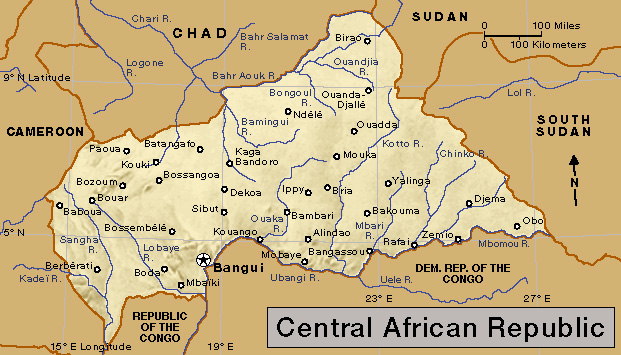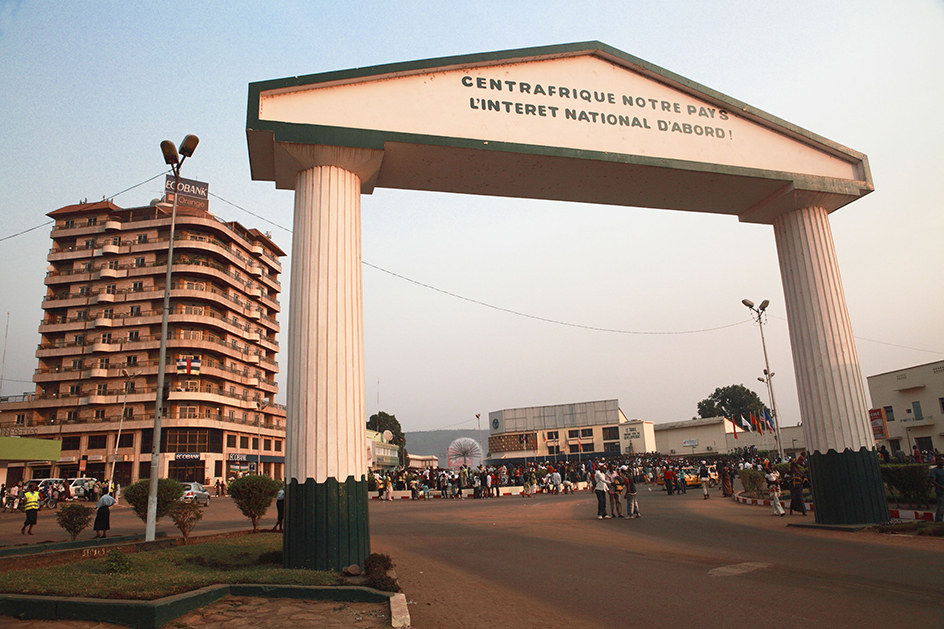Central African Republic is a thinly populated country in the center of Africa. Most of the Central African Republic is a vast, rolling plateau broken by deep river valleys. Grass and scattered trees cover most of the country. Rain forests grow in the southwest, and the extreme northeast is arid. Antelope, buffaloes, elephants, gorillas, lions, rhinoceroses, and other animals live in the Central African Republic.

The Central African Republic is one of the least developed countries in Africa. Many of the people are farmers, and the country has little manufacturing. The country was formerly a territory in French Equatorial Africa called Ubangi-Shari. It became independent in 1960. Bangui, a river port, is the capital and largest city of the Central African Republic.
Government.
The Constitution of the Central African Republic was adopted in 2015. A president, elected for a five-year term, serves as head of state. The president appoints a prime minister, who serves as head of the government. The country’s legislature is called the National Assembly. Voters elect Assembly members to five-year terms. The Supreme Court is the country’s highest court.

People.
Rural Central Africans hunt, fish, and raise food crops to feed their families. They also raise cattle, goats, pigs, sheep, and poultry.
Loading the player...Central African Republic's national anthem
The people of the Central African Republic belong to many ethnic groups and speak many languages, of which the most common is Sango. About 50 percent of the people are Christians, and about 15 percent are Muslims. The rest of the people practice local African religions. Many adults in the Central African Republic cannot read or write. About 60 percent of the children receive an elementary school education. The country also has secondary schools and a university.
Land.
The plateau that makes up most of the Central African Republic has an average altitude of about 2,000 feet (600 meters) above sea level. Areas in the northeast and on the country’s western border with Cameroon rise more than 4,500 feet (1,370 meters) above sea level.
Many rivers flow through the country. In the north, most are tributaries of the Chari River, which flows north to Lake Chad (see Lake Chad). A divide separates these rivers from those that flow south from the central and southern parts of the country to the Congo River Basin. Many of these rivers are tributaries of the Ubangi River, which joins the Congo River. The Ubangi and one of its tributaries, the Mbomou River, form most of the country’s southern boundary with the Democratic Republic of the Congo.
The country has a fairly comfortable climate, mainly because of its altitude. The average temperature is 80 °F (27 °C). Each year, the country receives about 311/2 inches (80 centimeters) of rainfall in the north and about 63 inches (160 centimeters) in the south. The rainy season extends from June through October in most parts of the country. In the southwest, rain may fall throughout the year.
Economy.
The Central African Republic is a poor country. Agriculture is an important economic activity. Beef cattle are the leading livestock product. Farmers grow bananas, cassava, coffee, corn, cotton, peanuts, and yams. The country’s forests supply timber and other wood products. Diamonds and gold are the leading mined products. Manufacturing plays only a small role in the economy.
The Central African Republic has a poor transportation system. The country is landlocked, has no railroads, and has only a few paved roads. Rivers form the most important transportation routes. Bangui has an international airport. Bambari, Bouar, and several other towns have smaller airports.

History.
Before the arrival of Europeans in the 1800’s, most of the people of what is now the Central African Republic lived in local societies. Slave raids in the 1800’s brought turmoil to the region. In 1889, France established an outpost at Bangui. The French created the territory of Ubangi-Shari in 1894. In 1910, they linked Ubangi-Shari with what are now the countries of Chad, Gabon, and the Republic of the Congo to form French Equatorial Africa.

The French established a local parliament in Ubangi-Shari in 1946. Elected members represented the country in the French parliament. In 1958, the country gained internal self-government as the Central African Republic. It joined the French Community, an organization that linked France and its overseas territories. The country became fully independent on Aug. 13, 1960.
The first prime minister and leading political figure, Barthelemy Boganda, was killed in an air accident in 1959. His nephew David Dacko succeeded him and became the country’s first president in 1960.
The country became a one-party state in 1962 and, in 1964, Dacko was elected to a seven-year term as president. But in 1966, army officers overthrew him. Jean-Bedel Bokassa, head of the army, became president. In 1972, Bokassa was named president for life. From 1975 to 1976, Elisabeth Domitien served as prime minister. She was the first woman to serve as prime minister of a sub-Saharan African country. In 1976, Bokassa declared himself emperor and changed the country’s name to the Central African Empire. In 1979, supporters of Dacko overthrew Bokassa, and Dacko again became president. Bokassa went into exile in France. The country’s name was changed back to Central African Republic. In March 1981, the country became a multiparty state again, and Dacko was elected president.
In September 1981, army officers overthrew Dacko once more and took control of the government. General Andre Kolingba was declared president. The new military government banned all political parties. In 1992, the government restored a multiparty political system in the country. Multiparty elections were held in 1993 for president and the National Assembly. Ange-Felix Patasse was elected president.
Bokassa had returned to the Central African Republic in 1986. In 1987, a court convicted him of embezzlement and murder, and he was imprisoned. In 1993, he was released from prison.
In the mid-1990’s, soldiers staged several revolts against the government of President Patasse. Hundreds of people were killed and thousands of residents were forced from their homes during the fighting. A cease-fire agreement ended the hostilities in mid-1997. Patasse was reelected president in 1999. Rebel uprisings again took place in May 2001 and October 2002. Government forces, aided by Libyan troops, put a stop to the fighting both times.
In March 2003, rebels led by General François Bozizé seized control of the government. Bozizé suspended the country’s Constitution, dissolved the parliament, and declared himself president. In 2004, voters approved a new constitution. In 2005, presidential and parliamentary elections were held under the new Constitution, and Bozizé won the presidential race. He was reelected in 2011. In March 2013, a rebel army captured the capital and overthrew Bozizé, who fled the country. The rebels accused Bozizé of failing to honor the conditions of a peace deal they had reached in January.
Violence continues to plague the Central African Republic as rebel groups battle one another. The United Nations sent peacekeepers to the country to try to contain the violence. In late 2015, the Central African Republic held a referendum (public vote) in which voters approved a new constitution. Elections were held in late 2015 and early 2016. Voters elected former Prime Minister Faustin-Archange Touadéra to the presidency. He was reelected in 2020.
See also Bangui; French Equatorial Africa; Ubangi River.
